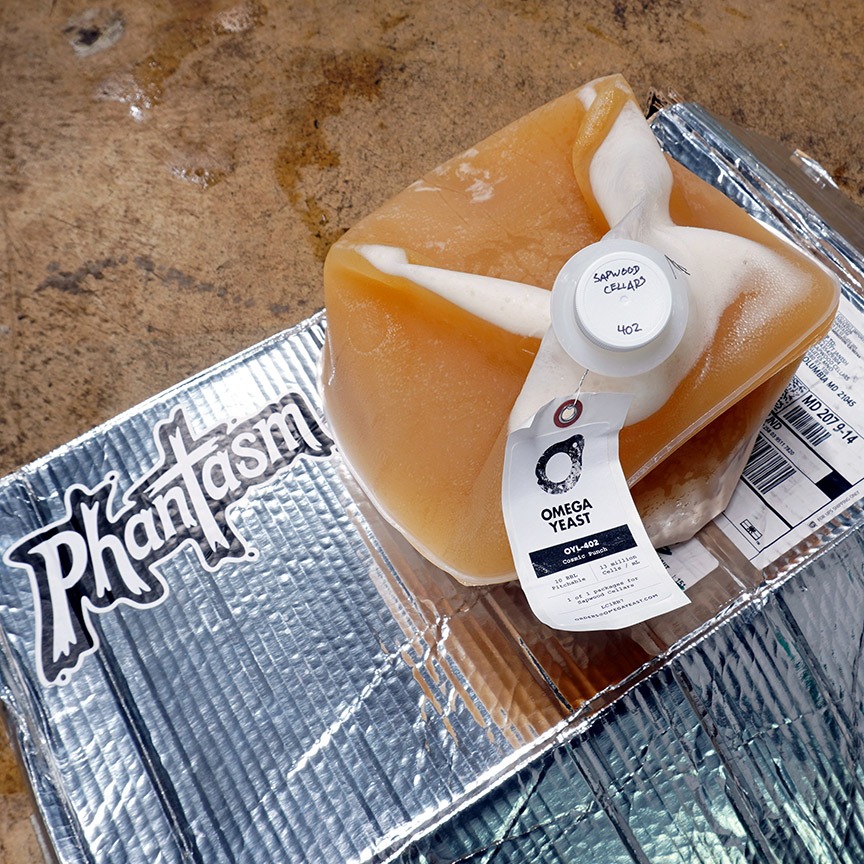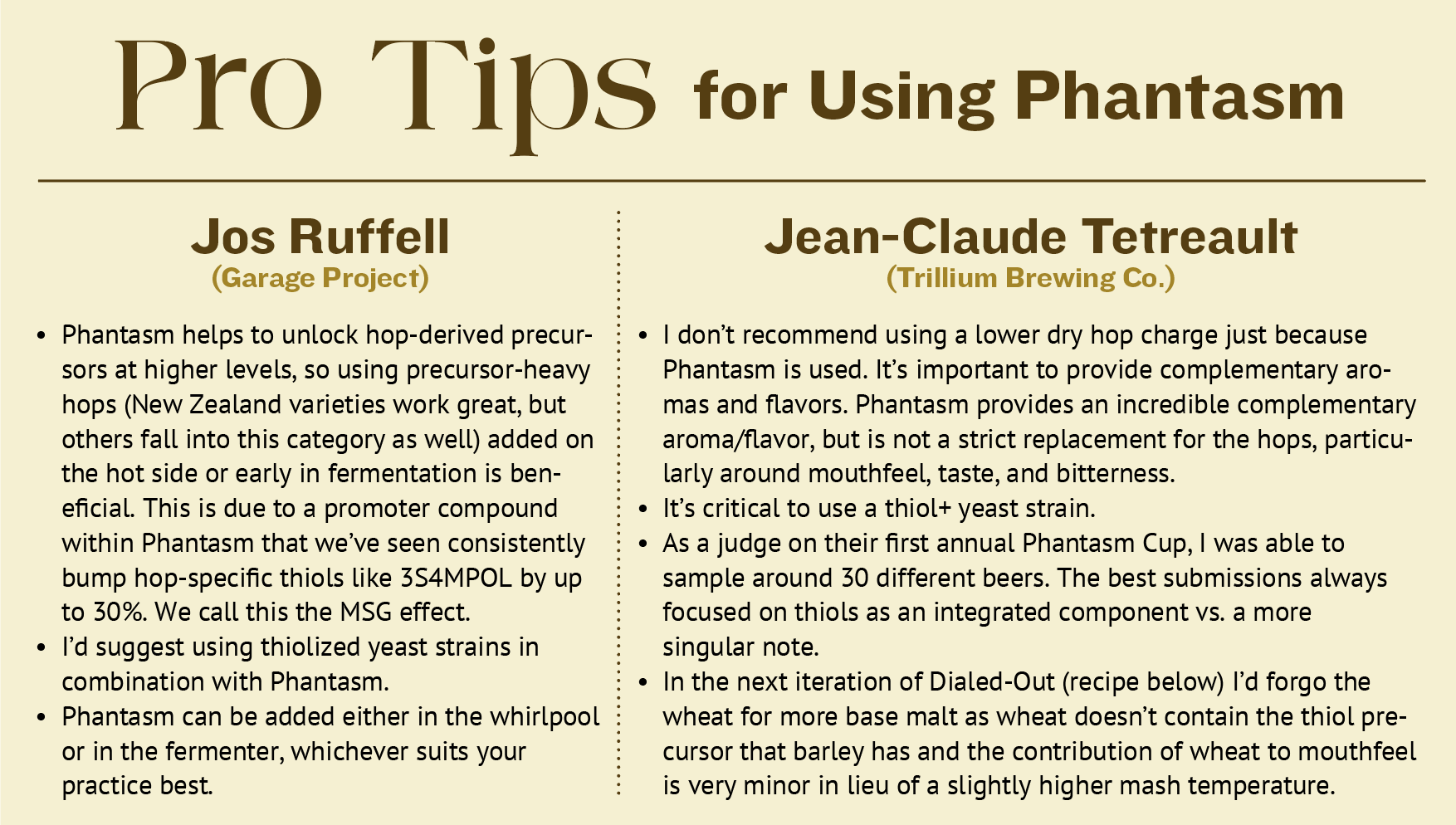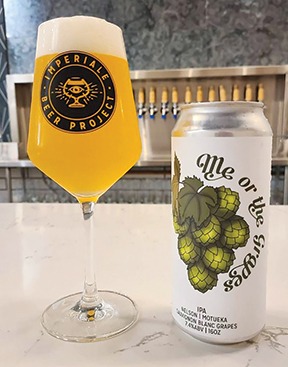Thiol Boosting with Grape Skins

Phantoms! Eerie tales of suspense . . . No not those, we’re talking Phantasm powder and how to brew with it!
My first recollection of this new mysterious brewing ingredient was a few years ago when I was a commercial brewer. I was out enjoying a beer with several other local brewers when the topic of recipe development came up. One asked the group, “have you played with Phantasm yet!?” Not knowing about it, I assumed it was a new branded hop extract similar to Incognito or something since our conversation was centered around whirlpool hop additions at that time. To my surprise, I learned through the flow of conversation that it’s actually an extraction from New Zealand Sauvignon Blanc grapes that are rich in thiol precursors.
Without going down a Douglas Adams-esque rabbit hole on thiols, they’re an organosulfur compound that contains a sulfhydryl group along with more than one organic functional group, for example 3-sulfanyl-1-hexanol (3SH). Depending on the specific thiol’s makeup, it can smell like anything from citrus to garlic and even roasted coffee. In layman’s terms, thiols are like a periodic table of aromas! I’ll refer you to the story Are Thiols Worth the Hype” for more on the subject of thiols. But it is important to understand what they are in order to understand what Phantasm is and how to brew with it.
So What is Phantasm?
Let’s dig into Phantasm’s backstory, because it truly does embody the spirit of brewing your own. You can’t talk about Phantasm without referencing its creator, Jos Ruffell. He is the Co-Founder of an amazing brewery in New Zealand called Garage Project. It was through his love for brewing and learning about hops that this innovative new ingredient was born. If you love hoppy beer, chances are you probably are familiar with and have enjoyed some of the hop varieties coming out of New Zealand. The aromas on hops like Nelson SauvinTM, MotuekaTM, RiwakaTM, etc. have big, bold exotic fruit characters that you just don’t find with hops grown north of the equator. Call it climate, or soil, or terroir — they are just different and in a really good way.
Jos learned these hops are high in thiols, specifically one called 3SH (remember that example earlier?). This thiol precursor when metabolized (biotransformation) by yeast produces passion fruit and guava aromas. Specific yeast strains do this better than others, but let’s not get ahead of ourselves yet. Back to Jos and his musings down under. New Zealand is also a renowned wine-producing region. In fact, most of thiol research as it pertains to the wine industry is coming out of New Zealand and is centered around Sauvignon Blanc grapes grown in the Marlborough region. These grapes are also very high in the specific thiol 3SH. It was through this understanding of similarities that Jos became inspired to explore how these grapes might be utilized in the brewing process.
Brewers, especially those making sour beers, have long used pressed grape skins and lees (primarily dead yeast cells, similar to trub in brewing) to impart flavor and aroma in beer. But neither of these methods offer particularly shelf-stable products, nor was the chemistry understood as fully as it is today. Through trial and research, Jos created a process in which he was able to extract high concentrations of these thiol precursor compounds from Marlborough’s expressive Sauvignon Blanc grapes to create a preserved product capable of being sold commercially. It was around late-2020 when Phantasm first hit the market and by mid-2021 everyone was talking about it and the beers produced using it.
Putting Phantasm to Use

It was around this same time that I and the other local brewers were having that conversation about using it. Lucky for me I had also been working with a local commercial yeast company called Berkeley Labs that had been doing some amazing things with genetically modified yeast. I had primarily been using their Galactic strain, a Saccharomyces strain that produces both lactic acid and alcohol. Long story short, it was through this relationship that they asked me if I wanted to try another new strain that was currently in development. After signing some NDAs to not share it, etc. I got my hands on one of the keys to unlocking Phantasm’s highest potential. It essentially was a strain that would go on to be known as thiolized yeast. Fast forward to today’s brewing world, a few different companies are offering thiolized yeasts that are either selected and bred up using traditional methods or genetically modified to greatly increase the given strain’s ability to unlock thiol precursors.
That leads us into using Phantasm powder in brewing. I’ve brewed several batches using Phantasm now, both large and small, and describe it as a player in the symphony that is your beer. We know the musical notes the instrument produces (guava and passion fruit aroma). As the conductor (brewer) the choice is yours to either seat it in the back or up front and even amplify it if you choose to do so. In my brewing experience with it and in talking with Jos (more on that in a minute) the best place to use it is with your whirlpool additions or as a biotransformation hop addition; i.e., when you pitch yeast or within the first 24–48 hours of fermentation. Remember the key to unlocking thiol precursors is through that biological bag of enzymes that we call yeast (biotransformation).
Back to the symphony analogy, the amount (0.5–1 oz. per gallon/ 3.7–7.5 g/L) represents how many players of that instrument are present in your orchestra. The choice of a yeast strain is its placement, either in the front or the back. Some yeast strains are high and some low in their ability to produce thoils. Then you have your genetically modified strains that are essentially amplifiers for that instrument section. Let’s not forget the other players, like malt and hops. They too not only contribute other flavors and aromas to the symphony (beer) but they also have their own thiol precursors as well. Having experimented with Phantasm quite a bit, when used with thiolized yeast and prior to any dry hopping, you would swear the beer had guava and passion fruit in it from the aroma. Then when used with something like the Chico strain, the aroma is more subtle. So it really all depends on what you’re going for and trying to brew. To be clear, we’re talking aroma here, not taste. If you want a big fruit bomb aroma go on the high end of the recommended dosage amount and use a thiolized yeast. The recipe is a guideline, your sheet of music to create, and you’re the maestro!
I mentioned earlier talking to Jos about recommended usage. Not only was he super open and bounced me several emails about Phantasm, so was someone else he brought into the email thread, Jean-Claude Tetreault, Co-Founder and Brewer of Trillium Brewing. Trillium, of course, is renowned for their hazy IPAs coming out of Canton, Massachusetts, and their other locations around the state, some of which use Phantasm to boost the tropical character. Not only that, Jean-Claude was also a judge in the first annual Phantasm Cup held last December at Half Acre Beer Co., in which more than 75 breweries entered beers that used Phantasm. Jean-Claude even supplied me with their recipe for Dialed-Out — a double IPA brewed with Sauvignon Blanc grape juice, Phantasm, and hopped with Citra®, Nelson SauvinTM, and RakauTM. That clone recipe is below. I’m also sharing one of my commercial recipes below that uses Phantasm called Me or the Grapes. It’s a beer I brewed with grapes as well, which I had the pleasure of picking from a local winery in Brentwood, California. Either of these recipes can be brewed with or without the grape juice, but both are inspired by this innovative product and its roots on the vine, Phantasm.

Trillium Brewing Co.’s Dialed-Out clone

(5 gallons/19 L, all-grain)
OG = 1.080 FG = 1.016
IBU = 10 SRM = 5 ABV = 8.5%
Ingredients
14.5 lbs. (6.6 kg) Pilsner malt
1.5 lbs. (0.68 kg) flaked wheat
3 oz. (85 g) Crisp Caramalt (15 °L)
2.9 AAU Columbus hops (first wort hop) (0.2 oz./6 g at 14.5 alpha acids)
0.8 oz. (23 g) GalaxyTM hops (hopstand)
0.4 oz. (11 g) Nelson SauvinTM hops (hopstand)
5 oz. (140 g) Phantasm powder (fermenter)
10 oz. (280 g) GalaxyTM hops (dry hop)
5 oz. (140 g) Nelson SauvinTM hops (dry hop)
2 bottles (1.5 L) New Zealand Sauvignon Blanc wine (fermenter)
Omega Yeast OYL-402 (Cosmic Punch) or similar thiol-enhancing yeast strain
3⁄4 cup corn sugar (if priming)
Step by Step
Be sure to account for the addition of the wine to the fermenter as it is a sizable addition.
Starting with soft or reverse osmosis water, build up to your favorite softer IPA water profile with a little calcium chloride and Epsom salt. Mash in at 153 °F (67 °C) and hold for 40 minutes before beginning the lautering process. Add the Columbus hops to the kettle during the sparge. Boil for 60 minutes. When the boil is complete, cool the wort to 165 °F (74 °C) and add the hopstand hops. Begin a whirlpool and spin for 10 minutes. Allow wort to settle another 10 minutes then chill to yeast-pitch temperature.
Transfer wort to fermenter, aerate well, and pitch yeast. Ferment at 68 °F (20 °C). After 2 days of fermentation, add the Phantasm powder. After four days add a favorite New Zealand Sauvignon Blanc wine. Add the dry hops 36–48 hours after reaching terminal gravity.
After two days on dry hops, move to a serving keg and force carbonate to 2.5 v/v or bottle and prime with sugar.
Partial mash option: Reduce Pilsner malt to 2 lbs. (0.91 kg) and utilize 7.3 lbs. (3.3 kg) Pilsen dried malt extract. Mash the flaked grains and crushed malts in a large grain bag in 2 gallons (8 L) water at 153 °F (67 °C) for 60 minutes. Remove the grains and place in a colander. Rinse grains with 1 gallon (3.8 L) of hot water. Top kettle up to 6 gallons (23 L), add first wort hops and malt extract off heat. Stir until fully dissolved, then bring to a boil. Follow all-grain instructions, being sure to top fermenter up to 5.25 gallons (20 L) before starting fermentation.
Imperiale Beer Project’s Me or the Grapes clone

(5 gallons/19 L, all-grain)
OG = 1.065 FG = 1.010
IBU = 12 SRM = 4 ABV = 7.3%
Ingredients
11.5 lbs. (5.2 kg) Viking Xtra Pale malt
1 lb. (0.45 kg) flaked oats
1 lb. (0.45 kg) flaked wheat
4 AAU Nelson SauvinTM hops (first wort hop) (0.25 oz./7 g at 12% alpha acids)
2.75 oz. (77 g) Nelson SauvinTM hops (hopstand)
2 oz. (56 g) MotuekaTM hops (hopstand)
6 oz. (170 g) Phantasm powder (hopstand)
6 oz. (170 g) Nelson SauvinTM hops (dry hop)
6 oz. (170 g) MotuekaTM hops (dry hop)
7 oz. (207 mL) Sauvignon Blanc juice
Omega Yeast OYL-404 (Star Party) or similar thiol-enhancing yeast strain
3⁄4 cup corn sugar (if priming)
Step By Step
For this recipe I shoot for a “hoppy lite” water profile and a mash pH around 5.4. Mash in at 149 °F (65 °C) and recirculate for about 45 minutes before sparging. Add the FWH as you transfer into the kettle. Boil for 60 minutes. With 5 minutes left in the boil add a yeast nutrient and Whirlfloc, if desired.
At flameout, start your whirlpool and cool wort to 180 °F (82 °C) before adding the hopstand hops and Phantasm powder additions. After whirlpool is complete, cool your wort to 64 °F (18 °C) and transfer to your fermenter along with the juice. Allow fermentation temperature to rise a degree or two, 65–66 °F (18–19 °C), depending on the strain. When fermentation is complete, bottle condition or keg and carbonate.
Note on whirlpool IBU and hopstand: If you plug this recipe into your brewing software you might notice your IBUs are different depending on your whirlpool/hopstand configurations. At the brewery I would typically whirlpool for 15 minutes and then let the kettle rest for 15 minutes before starting my transfer, which would take another 30 minutes or so.
Partial mash option: Reduce pale malt to 2 lbs. (0.91 kg) and add 5.5 lbs. (2.5 kg) extra light dried malt extract. Mash the flaked grains and crushed pale malt in a large grain bag in 2 gallons (8 L) water at 149 °F (65 °C) for 60 minutes. Remove the grains and place in a colander. Rinse grains with 1 gallon (3.8 L) of hot water. Top kettle up to 6 gallons (23 L), add first wort hops and malt extract off heat. Stir until fully dissolved, then bring up to a boil. Follow all-grain instructions, being sure to top fermenter up to 5.25 gallons (20 L) before starting fermentation.



